If you’re planning to serve turkey as the main course for your festive feast, you might be wondering how to choose, prepare and cook a turkey for Christmas dinner.
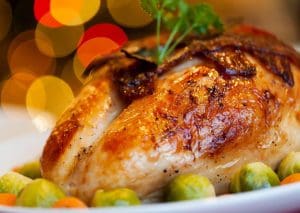 Turkey is a popular choice for Christmas lunch because it is lean, high in protein and low in fat.
Turkey is a popular choice for Christmas lunch because it is lean, high in protein and low in fat.
It also has a mild flavour that goes well with many different seasonings and sauces.
We also discuss how to brine a turkey and the advantages it brings – namely a quicker cooking time – but you’ll need to be careful about not over-seasoning the gravy since the brining technique uses salt.
Some people choose to eat turkey for Christmas because it is part of their family tradition or because it wouldn’t be Christmas otherwise!
Here, we offer tips and advice to help you make your turkey Christmas dinner a success.
Why choose turkey for Christmas
Why people choose turkey for Christmas include:
- The size of the bird: The larger size of a turkey compared to a chicken makes it ideal for feeding a large group if you have friends and family around for Christmas dinner- consider that a standard ‘large’ chicken will easily feed three or four adults
- Following tradition: Many people choose to eat turkey at Christmas simply because they consider it the traditional meal. It is something they associate with Christmas, and it is possibly the meat they have eaten on Christmas Day since they were a child
- The taste and texture: Some people prefer the taste and texture of turkey over other meats, especially if it is cooked well and served with stuffing, gravy and cranberry sauce
- The versatility: Turkey can be cooked in different ways, such as roasting, frying or smoking, and it can also be used for various dishes after Christmas, such as sandwiches, pies or soups.
oooOooo
What to look for when buying a turkey
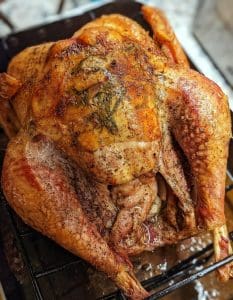 There are different types of turkey available, such as free-range, organic, bronze or white. You can also choose between a whole turkey, a turkey crown or a boneless turkey breast.
There are different types of turkey available, such as free-range, organic, bronze or white. You can also choose between a whole turkey, a turkey crown or a boneless turkey breast.
The best option depends on your budget, preference and the number of people you’re feeding.
Size matters: Determine how many guests you’ll be serving and calculate the size of the turkey accordingly. A general rule of thumb is to allow between 450-500g per person – though this includes the bones in the turkey. However, if you want leftovers for sandwiches or curries, consider going a bit larger.
- Your oven: Another crucial issue is the size of your oven when choosing a turkey for Christmas dinner. You should appreciate that very large birds need a lot of oven space and take a long time to cook. For example, an 8kg bird for 14-16 people takes 9 hours to cook – you will need a very large oven for that and get up early on Christmas Day to start cooking to ensure the turkey is properly cooked for everyone. A better alternative, we think, for anyone entertaining a big group of guests is to cook two smaller birds because these will a) fit in your oven and b) cook properly for dinner. It also means that the birds will take less time to cook and you’ll have an oven free to cook your roast potatoes and Yorkshires!
- Fresh or frozen: Decide between a fresh or frozen turkey. You can buy a fresh or frozen turkey from your butcher, supermarket or online. Fresh turkeys tend to be juicier, pricier and have a more natural taste, but they are usually only available in the days before Christmas when demand will be strong – so you might need to order one. Frozen turkeys are readily available and can be bought in advance, but they require thawing before cooking. You can read more about the process to thoroughly defrost a turkey, but you should also appreciate that a 4kg frozen turkey that will feed 10 people will need 18 hours to thaw. That means being organised on Christmas Eve – and if you don’t begin the thawing process in time, it’s unlikely you will be able to safely cook your turkey. Also, if you buy a frozen turkey, make sure you have enough space in your freezer and fridge to store it safely.
Christmas.co.uk Top Tip: To avoid food poisoning it is crucial that the bird has been thoroughly defrosted – a partially defrosted turkey that is cooked runs the risk of giving guests food poisoning. Always read the label on defrosting a turkey to avoid this issue.
- Quality and source: Look for turkeys from reputable sources, preferably free-range or organic, which ensures better animal welfare and quality of the meat.
As an alternative to buying and cooking a large turkey, it might be worth considering cooking a turkey crown on Christmas Day. You can read more about how to buy them and how to cook a crown here.
How to prepare a full-sized turkey
Once your full-sized turkey is defrosted, remove it from the packaging and pat it dry with kitchen paper.
You can season it with salt, pepper and herbs, or stuff it with your favourite stuffing recipe.
Add some extra flavour and moisture by rubbing butter under the skin of the breast or cover the breast with bacon or foil.
You can also put some aromatics, such as onion, garlic, lemon or herbs, inside the cavity of the bird.
Some people also brine their turkey in the belief this is a great way to achieve a moist bird on Christmas Day.
How to brine a full-sized turkey at Christmas
For a succulent and full-flavoured turkey to grace your Christmas feast, consider experimenting with a brining technique before embarking on the roasting process.
Brining involves immersing the turkey in a solution infused with salt, a method that not only tenderises the meat but also imparts a lovely bouquet of aromatics. Here, we delve into two distinct brining methods for a full-sized turkey (NOT a turkey crown – we deal with this in our article on turkey crowns): the wet and dry brine for a Christmas turkey.
Among the famous chefs who advocate brining a turkey for improved taste and texture is Heston Blumenthal.
The purpose behind brining and its merits
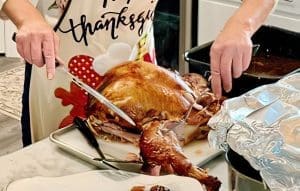 Brining serves to enhance poultry and meat with enhanced taste, heightened moisture and an improved texture. The mechanism driving this transformation is osmosis – which we all remember from our school science lessons.
Brining serves to enhance poultry and meat with enhanced taste, heightened moisture and an improved texture. The mechanism driving this transformation is osmosis – which we all remember from our school science lessons.
The brine is essentially a saline or salty liquid.
When the turkey is immersed in it, the moisture within the meat interacts with the brine until equilibrium in saltiness is reached.
And as the salt infiltrates the turkey, it begins to breakdown and relax the proteins in the meat.
The result of this is that the brined turkey will contract less during cooking – and maintain its succulence and this is where the aromatics really come into play and their flavours then permeate the meat effectively.
Brining proves particularly advantageous for drier and leaner meats, making it a suitable approach for turkey crowns and breasts.
Contrasting wet brining with dry brining
The wet brining process entails submerging or enveloping the turkey in a solution of salt. Conversely, the dry brine involves thoroughly rubbing salt onto the turkey’s surface. With a dry brine, the initial effect is moisture extraction from the turkey, followed by the formation of a salty liquid that is then reabsorbed.
Also, the skin will dry out, contributing to its crispness when roasted.
Among the two methods mentioned here, dry brining emerges as the more convenient option.
The turkey can be comfortably placed in a bag or container.
On the other hand, you’ll need a big bucket for wet brining to accommodate both the turkey and the liquid.
Both wet and dry brines can be enriched with flavours such as herbs, spices, garlic, and citrus zest, with the tastes effortlessly permeating the meat.
Tips for roasting a brined turkey
Post-brining, properly drain the turkey, discard the aromatic components, gently pat it dry with absorbent kitchen paper, and proceed with the roasting process as usual.
You can now use your favourite recipe for cooking a full-sized turkey and we offer great suggestions from Gordon Ramsay and Jamie Oliver below.
The cooking time for a brined turkey is a lot quicker and you should calculate a time saving of 10 minutes for each 500 grams of bird.
That’s a big effect on a turkey’s cooking time and in our example above – an 8kg bird for 14-16 people takes nine hours to cook – means the cooking time will reduce by up to 2 hrs 40 mins. For a busy kitchen with a lot of guests that could be a big time bonus.
That turkey will take 6hrs 20 mins – but ALWAYS check the bird’s temperature with a meat thermometer.
Finally, you’ll need to be careful when seasoning your gravy, as brined turkeys tend to absorb some of the salt used in the brining process and if the turkey is left for too long in the solution it can become too salty.
oooOooo
How to roast a turkey with Gordon Ramsay
Here is a hugely popular video from Gordon Ramsay on how to prepare a turkey.
He stresses that one great way to avoid dishing up dry turkey meat, is to prepare the bird thoroughly.
To do this he recommends lots of butter, olive oil and seasoning. The zest of two lemons to add flavour and garlic plus parsley.
He adds a lemon to the cavity and loosens the skin before adding the butter mix.
After cooking the turkey for a short time, when the skin is crisp, he adds bacon to the top and turns the heat down.
We think the addition of lots of butter is the secret to a moist turkey. Plus leaving the turkey to rest for up more than two hours leaves the cook plenty of time to get everything else ready!
This is a simple and impressive video that many people, especially those who aren’t confident in the kitchen, will learn a lot from.
oooOooo
How much turkey per person?
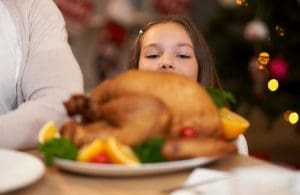 How much turkey should you prepare per person for Christmas dinner?
How much turkey should you prepare per person for Christmas dinner?
On average, it’s recommended to serve 150-175g of cooked turkey meat per person.
However, since turkey is often purchased as a whole bird, use our turkey guide for convenience.
Keep in mind that the meat-to-bone ratio varies based on the turkey’s breed.
Also, if you’re working within a tight budget, consider increasing the quantities of sausages, stuffing balls and vegetables while moderating the turkey portion. For those who are entertaining on a tight budget, this is a sensible route to follow – and there will be lots of diners who prefer the trimmings to the actual bird.
For your reference:
- A turkey crown (2-2.5kg) will feed 6 people.
- A small turkey (3-4.5kg) is for 6-8 people.
- A medium turkey (4-5kg) is enough for 8-10 people.
- A medium-large turkey (5-5.5kg) will feed 10-12 people.
- A large turkey (6-6.5kg) can generously serve 12-15 people.
How to roast a turkey for Christmas dinner
Here’s a quick guide on how to cook your turkey. The hot oven will help crisp the skin and get the turkey cooking before the temperature is turned down.
- Preheat your oven to 200C/Gas 6
- Put your turkey in a large roasting tin
- Place into the hot oven for 15 minutes
- Turn the temperature down to 180C/Gas 4
- Roast your turkey for 15 minutes per 450g/1lb
- Using a sharp knife, check the thigh juices run clear to ensure it is cooked
- If you aren’t sure, cook for another 15 minutes.
You can also use a digital cooking thermometer to check if your turkey is cooked.
When cooked, the internal temperature of the turkey should reach 70C. The turkey will continue to cook, and the temperature will rise as it rests.
oooOooo
Jamie Oliver’s fail-safe roast turkey recipe
It’s worth checking this video out from Jamie Oliver since this is another great, simple recipe to follow.
He recommends taking the turkey out of a fridge at least two hours before cooking which will bring the bird up to room temperature.
Jamie also recommends using a free-range turkey because it is more ethical and offers better flavour.
We also liked the tip to cook onions, celery and carrots plus the neck underneath the turkey for the gravy.
He rubs butter over the bird and seasons generously with salt, pepper and nutmeg.
Jamie then prepares the stuffing and places it in the neck rather than the cavity to help air flow.
He also puts in clementines and rosemary or thyme.
We also liked Jamie placing a meat thermometer in the bird so the cook ‘can see what is going on’.
Jamie also adds these cooking times to help:
- Preheat your oven to 180ºC (350ºF, Gas Mark 4)
- For turkeys under 4.5kg allow 45 minutes per kg and another 20 minutes
- For turkeys that weigh between 4.5kg and 6.5kg then you should allow 40 minutes per kg
- For larger turkeys of 6.5kg or more, then allow 35 minutes per kg.
After basting and taking the foil off, the skin is crisp and golden. He also leaves it to rest for two hours.
oooOooo
How and why do we rest a roasted turkey?
If you are planning to cook a turkey for your festive dinner, you might be wondering how to make sure it is juicy, tender and packed with flavour.
One of the most important steps is to rest the turkey after roasting and before carving.
But why is this so crucial and how long should you do it for?
Resting the turkey allows the meat to relax and reabsorb its juices, which are driven to the surface by the high heat of the oven.
The resting time depends on the size of your turkey, but generally you should allow at least 30 minutes and up to 90 minutes. As we have seen from the Jamie and Gordon videos above, they rest their bird for at least two hours.
This prevents the meat from drying out and makes it easier to carve.
The resting time for a turkey also gives you the opportunity to make the gravy and finish the vegetables, without worrying about the turkey getting cold.
You can read our articles on cooking vegetables for Christmas dinner and, of course, lovely Yorkshire puddings to impress.
Christmas.co.uk top tip: To help you plan effectively and understand which dishes you can be preparing when your turkey is resting, please read our special Christmas Day cooking schedule.
When resting a turkey, cover it loosely with foil and place it in a warm area of the kitchen.
The turkey will continue to cook, and the internal temperature will rise by about 10°C.
To confirm your turkey is cooked, insert a meat thermometer into the thigh’s thickest part – avoiding the bone.
The temperature should reach at least 70°C for a conventional turkey or 65°C for a free-range one.
You can also pierce the meat with a knife and see if the juices run clear, with no sign of pink.
Remember, since the turkey has been covered in foil, it won’t go cold while it is resting!
How to carve a turkey
 Even though your turkey will be rested for up to two hours (or more…) it will not be cold, but it will become juicier and easier to carve.
Even though your turkey will be rested for up to two hours (or more…) it will not be cold, but it will become juicier and easier to carve.
To carve your turkey, use a sharp knife and a carving fork.
To streamline the carving process, consider removing the wishbone before cooking. Once your roasted turkey has been rested, follow these steps.
Detach the legs
Position the roasted turkey on a cutting board with the breast facing upward. Untie the string binding the legs together. Use a sharp knife, cut through the skin connecting the leg and breast, slicing downward until the joint is exposed. Gently pivot the thigh outwards and slice through the joint to detach the leg. Repeat this process for the opposite leg.
Separate the drumsticks and thighs
Select one leg and place it skin-side up on the cutting board. Carve through the knee joint, delicately detaching the thigh from the drumstick while maintaining a gentle pull. The thighs can be carved into sections or served whole, similar to the drumsticks. Duplicate this procedure for the other leg. Proceed by slicing through the shoulder joints to remove the wings.
Carve crown slices
There are two methods for carving the breast. The traditional approach involves slicing sections directly from the turkey’s body. Execute a horizontal cut beneath the breast, directed towards the breastbone for the smooth removal of slices. Carve slices of your desired thickness, moving from the top of the breast downwards to meet the initial horizontal cut. Repeat this sequence for the opposite breast.
Extract breasts and slice
Alternatively, you can start by removing the entire breast. Initiate a horizontal cut beneath the breast, followed by a lengthier cut alongside the breastbone. This action extracts the entire breast, which can be gently pulled away as you proceed. Position the breast with the skin side up on the cutting board and proceed to slice as per your preference. Replicate this process for the other breast.
What is the ‘grain’ for turkey meat?
The grain refers to the direction in which the bird’s muscle fibres run. If the meat is sliced with the grain, it will be tougher and have a stringy texture.
Slicing perpendicular or at a right angle to the grain breaks up the muscle fibres to deliver soft, tender slices.
Arrange the meat on a large platter and serve with your favourite trimmings.
How to carve a Christmas turkey – Jamie Oliver
Staying with Jamie Oliver, the Christmas.co.uk team enjoyed his take on how to carve a turkey.
The first step is to let the turkey to rest since this makes removing the legs easier.
The step-by-step instructions show how to remove the legs and wings and then easily carve big slices using a sharp knife and a fork.
However, Jamie also offers up a second way to carve a turkey and that is to remove the breast and slice that.
Again, he uses long strokes to carve and because there’s no bone to deal with most cooks will find this method easy.
How to enjoy your turkey
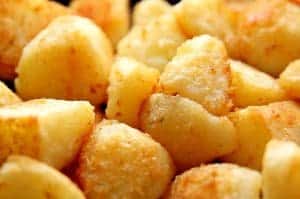 Finally, we all know that turkey is a delicious and versatile meat that can be enjoyed in many ways.
Finally, we all know that turkey is a delicious and versatile meat that can be enjoyed in many ways.
You can serve it hot on Christmas day with roast potatoes, parsnips, carrots, sprouts, pigs in blankets and gravy.
And any leftover turkey can be used to make soups, pies, curries or casseroles. It is also good for salads, sandwiches or wraps.
The Christmas.co.uk team has put together a list of great side dishes to consider on Christmas Day.
Alternatively, here’s a quick rundown on what goes well with roast turkey:
- Roast potatoes: A Christmas dinner isn’t complete without having fluffy and crisp roast potatoes. You can use any type of potato, but Maris Piper or King Edward are good choices. Peel and chop them into large chunks, then parboil them for 10 minutes in salted water. Drain them well and shake them in the colander to roughen up the edges. Transfer them to a large baking tray and drizzle with oil or melted goose fat. Season with salt and pepper – and either fresh or dried rosemary. Roast them in a hot oven for about an hour, turning them halfway through, until they are golden and crunchy
- Brussels sprouts: Another traditional side dish for the festivities are sprouts but they can be bland and bitter if not cooked correctly. To make them more appealing, try roasting them with some bacon, chestnuts and honey. Trim the ends of the sprouts and cut in half. Toss them with some oil, salt, pepper and a pinch of nutmeg. Spread them on a baking sheet and roast for 20 minutes, stirring occasionally. Add some chopped bacon and chestnuts and roast for another 10 minutes, until the bacon is crisp, and the sprouts are tender
- Cranberry sauce: This sweet and tangy sauce adds a burst of flavour and colour to your turkey. You can create your own by simmering frozen or fresh cranberries with orange juice and zest, plus some sugar, in a saucepan until the berries pop and the sauce thickens. You could add cinnamon, ginger or cloves if you enjoy extra ‘warmth’ from your sauce. Alternatively, you can buy ready-made cranberry sauce from the supermarket or online
- Bread sauce: This is a traditional British sauce made from breadcrumbs, milk, butter, onion, cloves, bay leaf and nutmeg. It has a creamy texture and taste that goes well with turkey and stuffing. To make it, peel and chop an onion and stud it with some cloves. Place it in a saucepan with some milk and a bay leaf and bring to a boil. Simmer for 15 minutes, then strain the milk and discard the onion, cloves and bay leaf. Return the milk to the pan and add the breadcrumbs, butter, salt, pepper and nutmeg. Stir over low heat until thickened and smooth. You could also add some cheese or cream for extra richness
- Pigs in blankets: These are small sausages wrapped in bacon that are roasted in the oven until crisp and juicy. They are a popular addition for guests on Christmas Day and make a great side dish for your turkey. You can use cocktail sausages or chipolatas. Wrap each sausage with a strip of streaky bacon and secure with a toothpick if needed. Place them on a baking tray and cook for 25 to 30 minutes in a hot oven, turning once or twice, until the bacon is crisp, and the sausages are cooked through.




